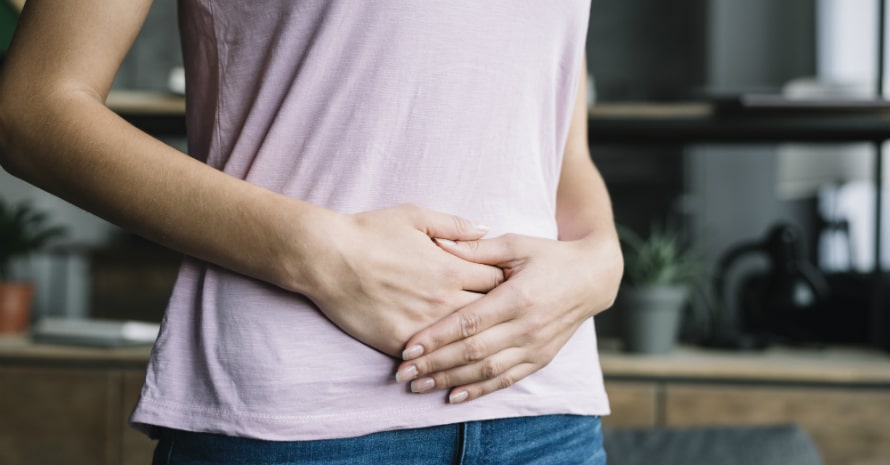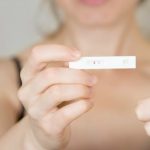Implantation Cramping: Understanding This Biological Process

Pregnancy is a result of the fusion between an ovum and a sperm. Once the egg is fertilized, it starts to grow and multiply. The zygote rolls down the womb to become what’s known as a morula. The morula grows into a blastocyst in the uterus and burrows into the womb. This process is known as implantation.
During the process above, many women experience implantation cramping, while others don’t feel these symptoms at all. If you are suffering from lower abdominal pain, it may be challenging to unravel whether it’s due to menstrual cramps or not. But if you are familiar with symptoms of cramping during ovulation, you can be calm and well-prepared for this condition.
Being a mother and studying to be a nutritionist, I want to share with you the essential information related to implantation specifics, pregnancy tips, and women’s health. Below, you can get a sneak preview of the facts you should know about implantation cramps, menstrual periods, and pregnancy.
Are You Experiencing Cramping Without Period? How to Deal with It?
If you feel cramping during a week or two before your period starts, you can get worried whether the feeling is a result of implantation. Thus, you may have some questions, for instance, “Is cramping a sign of pregnancy on its early stage?”. However, not every woman experiences the feeling when she gets pregnant.
The progesterone hormones are responsible for your abdominal pain and bloating. These hormones are multiplied during pregnancy and end towards the menstruation period. Therefore, it can be a bit challenging to tell a cramp pregnancy symptom from a menstrual period pain because the progesterone is responsible for both biological processes in a woman’s body.
If the abdominal discomfort you are feeling is not a symptom of implantation, what else can be responsible for the discomfort? If you are days away from the expected menstrual date, it could still be a result of the increased level of progesterone. This hormone increases in level in the second half phase of a woman’s menstrual cycle, thus, slowing down digestion and causing crump.
The woman’s menstrual cycle has two stages, the follicular and the luteal phase. The follicular is the “egg prep” stage, while the luteal is the “pregnancy waiting” period. Therefore, every month, whether you conceive or not, the body is always prepared for the pregnancy.
The increased level of progesterone during the pregnancy expectation phase has a higher likelihood of being the cause of the crampy feeling. Thus, the early cramping sign of pregnancy can be easily misunderstood.
Following the ovulation cycle and the mature egg release, the ovarian follicles form a corpus luteum with the primary function to secrete progesterone, at the same time, reducing the levels of estrogens. The progesterone produced is what transmits a message to the uterine wall to thicken.
Therefore, with a thickened uterine wall, if a woman gets pregnant during that cycle, the embryo reaches a conducive environment to grow since it can attach well. It is the reason behind an increased level of progesterone in the last stage of the “waiting pregnancy” phase before your menstruation is due.
The discomfort before the period can be worrisome. Hence, questions such as “How long after ovulation does implantation occur?” are frequently asked. Note that implantation has the possibility of occurring between 6-12 weeks after ovulation.
However, vast instances of implantation happen between 8-10 days after ovulation. If you want to conceive during this cycle, keep in mind that ovulation doesn’t equate to pregnancy. Besides, any symptoms you feel at this time may have no correspondence to the pregnancy possibility.
Thus, it is crucial to know and understand your ovulation cycle. For instance, by remembering days so far past the ovulation process, it is easier to rule out the symptoms that are not related to pregnancy. Therefore, if you are only five days after the ovulation cycle and experience some sorts of lower abdomen cramping, it can be easier to put things into perspective.
As I have mentioned, implantation takes between 8-10 days after ovulation. Therefore, you can give yourself a break and stop thinking of conceiving as the cause of the cramps.
Do Abdomen Cramps Always Accompany the Implantation Process?
Many women don’t show any implantation symptoms. However, the relative hormonal shift, in most instances, causes cramps. While cramping a week before period is not fun, experiencing concerns regarding what does implantation feel like is more severe and uncomfortable.
Note that this process is usually accompanied by a pulling, tingling, and prickly sensation in the lower abdomen, besides pressure. If you have an intense sharp abdominal tingling that resembles an implantation pain, I recommend checking up with your doctor.
Is Cramping Normal In Early Pregnancy? When Does It Occur?
I feel cramps a week before period starts, and I know that this feeling is not related to pregnancy. But the thing is, every woman differs from another. How long does implantation cramping last? It also varies for different women.
For instance, if you have a 28-days menstrual cycle, you are likely to feel cramps because of implantation on days 20-22 from the first day of the previous period. Thus, cramping before period can be due to an implantation process. Hence, early pregnancy sign cramps may be a symptom of conception.
What Does Implantation Cramping Feel Like?
Can you feel implantation? It is pretty similar to menstrual cramps. However, the difference is in the intensity of tingling and the abdominal sensation. During this period, a woman is prone to feeling pelvic discomfort that comes and goes in the repeated interval. So, is cramping normal during pregnancy? Yes, it is.
“Lately, I’ve been feeling lower back pain and stomach cramps could I be pregnant?” Here is a common question about symptoms of implantation and where they should be experienced, specifically in the body. This sort of cramps is usually felt in the middle of the entire pelvis. However, the intensity of pain shouldn’t be overly intense.
The cramps should not be felt on one side of the pelvis only. If you are feeling implantation signs and severe pains, on the side or in the midline of the pelvis, reach out to your doctor. Such a feeling can be nothing worrisome, reflecting cramps early pregnancy absence, but it is better to double-check.
Besides off-pelvis early cramps during pregnancy being associated with miscarrying, they can signal about an ectopic pregnancy, which happens outside the womb and in the fallopian tube. Such pregnancies are risky to the mother. Hence, if you experience such a feeling, seeing the doctor is something not worth missing for the safety of both you and the baby.
What Differentiates Pregnancy Cramping and Periods?
It can be challenging to distinguish these two feelings. However, the main difference between stomach pregnancy cramps and period pain is a positive result of a pregnancy test. Moreover, the difference is in answer to “how long does implantation last?” For instance, the cramping in early pregnancy is shorter and not as intense as it is with menstrual periods.
What’s more, early pregnancy cramps differ from the menstrual periods in some additional aspects. Obviously, menstrual pain occurs over a period. It happens averagely after every 28 days in case of pregnancy absence. The feeling takes place in the womb and its lining, which is a different case with implantation.
Prostaglandins substance in the womb compels the uterine muscles to relax and contract, and it causes inflammation and pain. The swelling and discomfort experienced during this time is the cause of the working muscles, no matter whether you endure cramps period late or as usual.
Are Cramps in Early Pregnancy Associated with Bleeding?
Not every woman experiences lower abdomen pains during pregnancy and bleeding. Recent studies showed that 25% of women do have bleeding and cramps during first trimester. It is important to note that only eight percent were heavily bleeding. Also, 28% of the participants who experienced spotting and less severe bleeding felt some pain. However, 54% of the applicants with heavy bleeding experienced pain, too. So, bleeding is also an individual symptom, and you need to monitor your health to be aware of the causes.
The Difference Between Spotting and Cramps During Menstrual Period
Some women notice non-period spotting once in a while, but to others, it is a common experience. How can you tell the distinctiveness between period cramps and spotting?
Spotting does not require critical treatment attention. However, identifying spotting time, the period it lasts, and other crucial details can help an individual to note what’s causing it.
For some women, menstruation starts or ends with spotting. Hence, it can sometimes be challenging to distinguish between the two.
What Differentiates Spotting from Menstruation?
It is crucial to note that spotting is any vaginal bleeding that is not related to woman’s monthly periods. Some women may experience light bleeding slightly before and shortly after the period. But if you have mastered your menstrual cycle understanding, you can always identify any change in your bodies, hence, easily recognizing spotting and monthly bleeding.
Menstruation bleeding is experienced approximately every 28 days. The womb wall thickens to prepare for the fusion of ovum and sperm. During this time, you may feel less intense ovulation cramping. However, if there’s no pregnancy, the uterine sheds off it’s lining to prepare for another period for conception. Below you can find my recommendations on how to differentiate the two cases:
- Menstruation
Menstruation has a regular schedule. Even though period time differs for women, most of them have their menstruation around the same period they experienced the last time.
Bleeding patterns of the menstrual period are predictable. Most women experience menstruation beginning with light spotting, turning heavy in the next 2-3 days, getting slightly lighter, and then ending with spotting.
You will experience notable symptoms. Weeks or days before the period, hormonal change invokes some feelings. They may range from breast tenderness to headache. As the womb contract to dismiss the uterine lining, you will likely experience more intense pain, more than cramps during early pregnancy.
- Spotting
Spotting has irregular timing. It can be experienced at any time of the month. Thus, it has no specific period to occur.
There’s a difference in color with menstruation. Some women may encounter brown blood, and others may find it somewhat lighter compared to the periods. Also, the texture and smell may differ.
Hormonal birth control medication can cause spotting. At the preliminary stage of new birth contraception, the hormonal change may bring this condition.
Is It Possible to Reduce Early Pregnancy Cramping?
It is arguably true that pregnancy cramps early signs are always mild. Hence, many times, there is no need for intervention to reduce pain intensity. However, when it happens, and the uncomfortable feeling becomes more unbearable to stand, there are some relief steps you can practice.
Take a Warm Shower to Reduce Cramps
The heat from the warm water bath can play a significant role in relaxing the uterine muscle. Thus, it will result in relieving abdominal discomfort and reducing even pregnancy week 12 cramps.
How to Relieve the Pain During Cramping but No Period?
Any warm compression with a heated pad on your pelvic can be of significant help. The use of a heated pad during pregnancy is safe as long as it doesn’t cause the mother’s core temperature to spike.
However, be very careful with a heated pad and make sure that it doesn’t go above 100 degrees Fahrenheit. As an option, you can use a special heating device on a localized part of the body for a short time of 10-15 minutes at most.
Taking OTC Pain Reliever to Reduce Cramping Early Pregnancy
If the pain intensity becomes unbearable, taking Acetaminophen becomes the safest option for you. However, I advise you to avoid Motrin and Ibuprofen to relieve cramping during early pregnancy.
Now that you know what causes period cramp, it is also essential to note that bleeding and spotting symptoms also accompany implantation. If you experience unbearable thin pain with heavy bleeding, I recommend you to see your doctor.
Frequently Asked Questions About This Subject
FAQ About Implantation Cramping
Below are the most common concerns regarding this topic. I have managed to answer them to help you with your questions regarding implantation cramping
How long does implantation discomfort last?
Many people wonder, “How long do implantation cramps last?” Well, the sharp implantation pain only lasts from a few minutes to a few days. Generally, it lasts for 1-3 days.
How is implantation cramping different from menstrual cramping?
Most women wonder, “What do implantation cramps feel like?” The progesterone produced during pregnancy implanting causes lower abdominal discomfort and pain, and it is not a critical condition. Menstrual cramping, conversely, is more severe. Moreover, menstrual cramps happen as a result of wombs contraction to expel its lining, which is then shed off as blood.
Does pregnancy implantation cause cramps?
The progesterone produced during implantation sends a message to the uterine wall to thicken and get ready for pregnancy, thus, reducing the number of estrogens. The thickened uterine prepares to hold the embryo in case of conception. Therefore, the increased level of progesterone awaiting implantation is responsible for the discomfort feeling.
When will I feel implantation cramping?
Not every pregnant woman feels implantation discomfort in her early pregnancy stage. However, it may happen two weeks or ten days after ovulation, approximately 2-7 days before the regular period. Thus, you can easily mistake implantation pain with regular menstrual periods cramps.
The Final Word
Typically, cramps are nothing worth worrying about. However, when they become severe, I recommended taking them into account. An excellent remedy is considering doing a home pregnancy test. You now know how to identify a variety of changes happening in your body with all the facts mentioned in this article.
For instance, if your test is negative, you can rule out pregnancy and start focusing on menstrual periods. Either way, if your pregnancy test turns out positive, and you experience bleeding, you can be in a position to identify what’s happening to your body. You can cross out either spotting or periods with a variety of aspects that reflect either of them.
Moreover, now that you’ve understood the ovulation cycle, analyzing your menstrual flow becomes easy. You can have a perspective on what will be happening in your body at a specific time. For instance, implantation takes place 8-10 days after ovulation. Thus, it will be easier for you to rule out chances of pregnancy and period approaching from experiencing cramps.
I hope that this article helped you to get the implantation process and cramps facts right. Have you ever experienced implantation cramping? Was the pain severe? What remedy did you use? Share your experience by commenting below.







